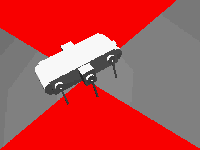#include <webots/robot.h>
#include <webots/servo.h>
#include <stdio.h>
#define NUM_SERVOS 6
#define NUM_STATES 2
#define RATE 1.0/6
#define smallSwap 2 * M_PI * RATE
#define bigSwap 2 * M_PI * (1-RATE)
#define TIME_STEP 16
#define AJUST_PERIOD 50
int main() {
const char *SERVO_NAMES[] = {
"servo_r0",
"servo_r1",
"servo_r2",
"servo_l0",
"servo_l1",
"servo_l2"
};
WbDeviceTag servos[NUM_SERVOS];
const int goForward [] = { 1, 1, 1, 1, 1, 1};
const int goBackward [] = {-1,-1,-1,-1,-1,-1};
const int turnLeft [] = { 1, 1, 1,-1,-1,-1};
const int turnRight [] = {-1,-1,-1, 1, 1, 1};
const double posSwap [NUM_STATES][NUM_SERVOS] = {
{smallSwap ,bigSwap ,smallSwap ,bigSwap ,smallSwap ,bigSwap },
{bigSwap ,smallSwap ,bigSwap ,smallSwap ,bigSwap ,smallSwap}
};
double pos[NUM_SERVOS] = {
-smallSwap/2,+smallSwap/2,-smallSwap/2,
+smallSwap/2,-smallSwap/2,+smallSwap/2
};
int i;
wb_robot_init();
for (i = 0; i < NUM_SERVOS; i++) {
servos[i] = wb_robot_get_device(SERVO_NAMES[i]);
if (!servos[i])
printf("could not find servo: %s\n",SERVO_NAMES[i]);
}
const int* dir = turnRight;
int state;
int elapsed = 0;
for (i = 0; i < NUM_SERVOS; i++ )
pos[i] = dir[i] * pos[i];
while(wb_robot_step(TIME_STEP)!=-1) {
elapsed++;
if(elapsed % AJUST_PERIOD!=0) continue;
state = (elapsed / AJUST_PERIOD + 1) % NUM_STATES;
for (i = 0; i < NUM_SERVOS; i++ ){
wb_servo_set_position(servos[i], pos[i]);
pos[i] += dir[i] * posSwap[state][i];
}
}
wb_robot_cleanup();
return 0;
}



